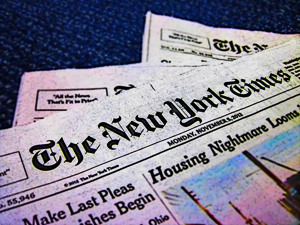I don't know whose arrogance is worse for the country: Donald Trump's, which takes legitimate fears about uncontrolled immigration to illegitimate extremes, or the New York Times editorial board's, whose editorials conflate legitimate fear with hysterical nativism.
In an editorial last month, the Times warned that Trump is not merely "a solitary phenomenon, a singular celebrity narcissist who has somehow, all alone, brought his party and its politics to the brink of fascism." It warned that Trump was part of a broader phenomenon conjured by Republicans who are "attuned to the power of fear" as they seek to build a wall against illegal immigration. It said Republican governors had joined "an axis of ignorance, declaring their borders closed to refugees fleeing the Islamic State in Syria."

That editorial is a metric of the Times' radical departure from the measured, reasoned, and moderate voice of its immigration policy editorials in the early 1980s. Congress at that time was in the midst of a five-year struggle that ultimately led to passage of the Immigration Reform and Control Act of 1986. IRCA, as it is widely known, is now infamous as a reform that failed because it was throttled by the peculiar left-right coalition of defenders of illegal immigration.
In 1983, a Times editorial warned that failure to contain illegal immigration would inevitably produce a public backlash against immigration. "For reasons of vitality, humanity and history, America wants and needs immigrants," the editorial observed. "What it does not need is such an uncontrollable flood of illegal migrants that it tries public patience and foments a backlash against all newcomers. That's the genuine danger." That editorial was titled "Time to Turn the Illegal Tide".
In 1985, the Times editorial board issued a prescient warning as it lamented the "many special-interest groups — farm workers, produce growers, civil libertarians and Hispanics, among others — [who] have made it their goal to defeat reform." The reference was to opposition to proposals to establish a worksite verification program to stop illegal immigration.
How the Times has changed. In the editorial from last month cited above, the current editorial board praised the American Civil Liberties Union, which never met a worksite identifier it couldn't tie up in the courts, and the Southern Poverty Law Center, which never saw an advocate of immigration controls that it couldn't label as intolerant and hateful. The paper hailed these obstructionists of effective reform as "civil rights groups ... defending the displaced against blatant discrimination."
The radicalized Times editorial policy is the creation of its publisher, Arthur O. Sulzberger, Jr. Sulzberger, who inherited his job from his late father, regards attempts to regulate immigration as a sin against the inclusiveness that is his gospel.
Sulzberger preached that gospel in a 2006 commencement address at the State University of New York at New Paltz. In what Vanity Fair called "a vapid political message", he told the graduates that they would have to make fateful decisions regarding such issues as "the rights of immigrants to start a new life; or the rights of gays to marry; or the rights of women to choose."
He made no distinction between legal and illegal immigrants as he declared, "You will choose at each point whether to be bold or hesitant, inclusive or elitist, generous or stingy."
The Times, which once regarded the regulation of immigration as vital to the United States, has come to see it as an evil. An axis of ignorance and arrogance now extends from Sulzberger's office to the editorial boardroom in the Manhattan glass tower that is the home of the New York Times.
